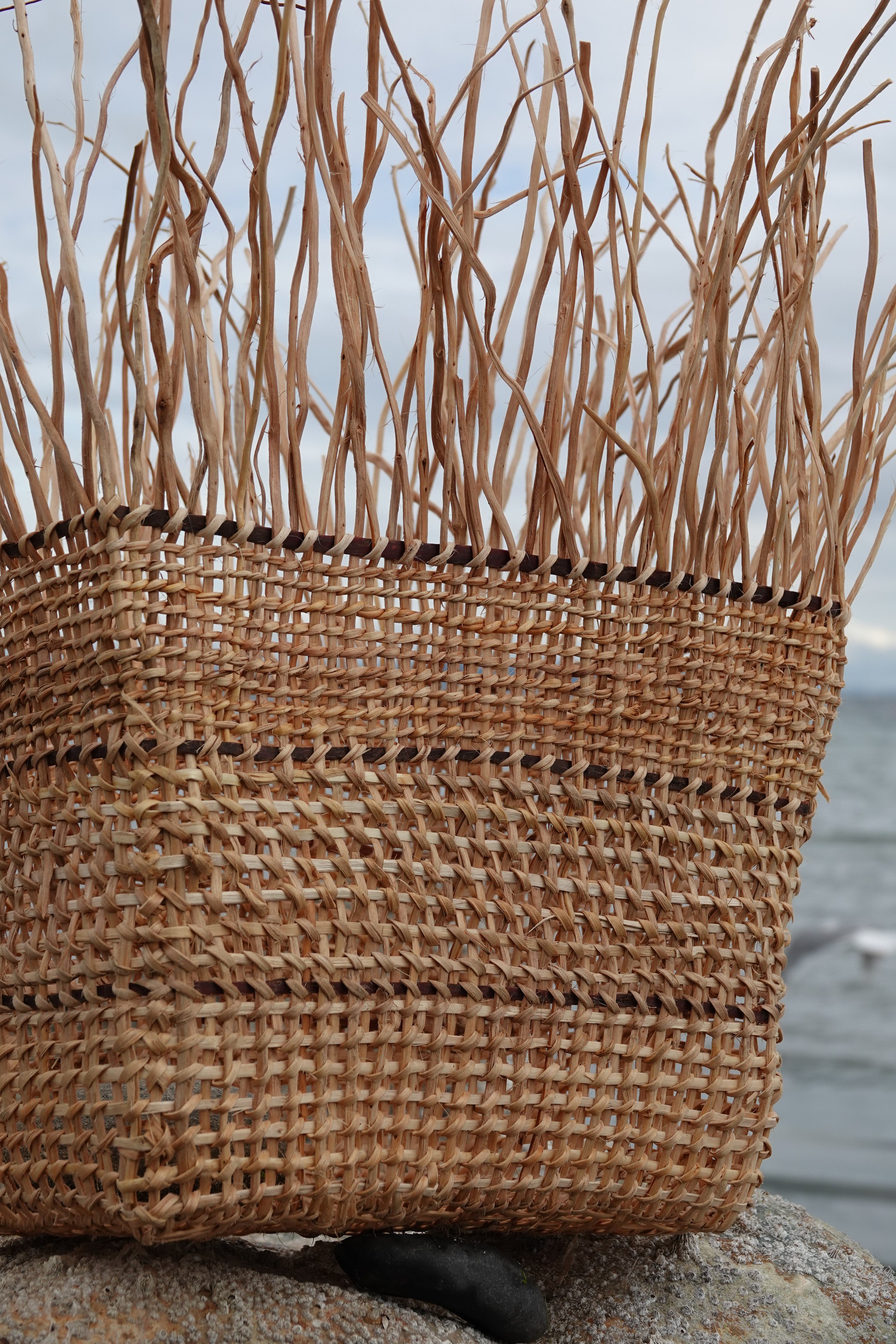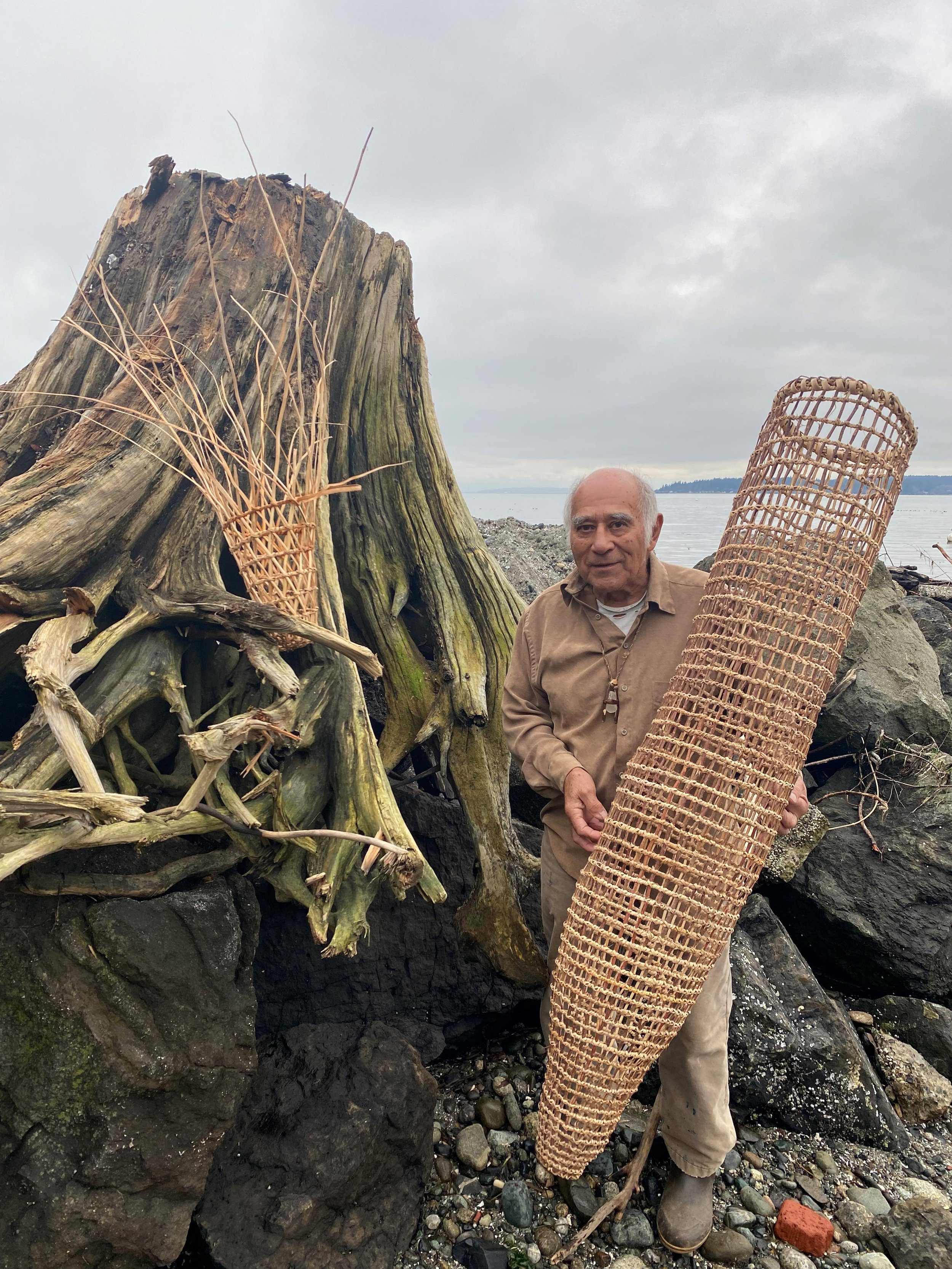The National Endowment for the Arts (NEA) has announced Ed Carriere, Suquamish Master Basketmaker and co-author of JONA Memoir 15, Re-Awakening Ancient Salish Sea Basketry, Fifty Years of Basketry Studies in Culture and Science (2018) (recently issued as a special hard cover edition by JONA in recognition of the award), as one of this year’s NEA National Heritage Fellows, recipients of our nation’s highest honor in the folk and traditional arts. For more than 40 years, the NEA has annually presented these lifetime honors in recognition of the diverse cultural traditions that comprise our nation and the individuals whose dedication and artistry contribute to their preservation and growth. Each fellowship includes a $25,000 award.
“The 2023 National Heritage Fellows exemplify what it means to live an artful life,” said NEA Chair Maria Rosario Jackson, Ph.D. “Their rich and diverse art forms connect us to the past, strengthen our communities today, and give hope to future generations in ways that only the arts can. Our nation is strengthened through their meaningful practices, expressions, and preservation of traditional artistry.”
Ed Carriere, Suquamish Master Basketmaker, 2023 NEA National Heritage Fellow, Indianola, WA. Photograph by Stuart Isett.
““I would personally like to thank the Ancestors whose baskets were preserved in archaeological wet sites for thousands of years so I could weave in honor of them. I could feel their hands helping my hands as I attempted to replicate their beautiful baskets. I also want to acknowledge the endless kindness of my Kia’h, my great-grandmother Julia Jacobs, who patiently raised me from birth and eventually to let me try my hands at making cedar clam baskets.””
Ed Eugene Carriere (Suquamish) learned the art of basketmaking from his great-grandmother, Julia Jacob of the Suquamish Tribe, who raised him from infancy. Jacob, born in 1874, was raised in a cedar plank longhouse called Old Man House, until she was a teenager, learning the early traditions of basketry; then her family was moved to their Indian allotment across the bay where Carriere currently lives. At age 14, he started to learn old-style split cedar limb and root Salish basketry and what became his lifetime specialty, clam baskets. Estimating from sales records, Carriere has likely made more than 600 clam baskets so far in his lifetime.
Carriere’s goal always was to learn basketry styles from as many generations back as he could. Through his tribal elders and museum collections, he was able to learn from five generations back. He then visited the 700-year-old Qwu?gwes archaeological waterlogged/wet site to help excavate preserved ancient clam baskets that are very similar to the ones he makes. Carriere literally was able to learn from his 30th and earlier generation grandparents, something he never dreamed could be possible.
Carriere helped to analyze a 2,000-year-old basketry collection from a Coast Salish wet site near Snoqualmie, east of Seattle and held at the University of Washington Burke Museum, which provided inspiration for him to replicate baskets from his 100th grandparent’s work. After making several beautiful replicas, he went to the University of British Columbia Museum of Anthropology to observe even earlier ancient Coast Salish wet site basketry, dating from 2,000, 3,000, and 4,500 years ago—fully 225+ generations back in Carriere’s Salish Sea traditions. Carriere decided to make a “book” by putting all these slightly different ancient styles of weave into one pack basket. He calls it an Archaeology Basket since it has “layers” of weaves from the different time periods.
Ed Carriere and archaeologist Dale Croes co-produced the JONA Memoir 15, Re-Awakening Ancient Salish Sea Basketry, Fifty Years of Basketry Studies in Culture and Science (2018) where they detailed each step in replicating ancient Salish basketry, and, through Croes’ statistical tests, showed how the ancient basketry styles link to his great-grandmother’s teachings; they call their approach “generationally linked archaeology.”
Carriere now presents his baskets for all future generations to learn from the deep-rooted cultural and arts heritage of the Salish Sea and peoples. In July 2022, Carriere was awarded the Community Spirit Award by the First Peoples Fund, honoring artists who embody their People's cultural assets in their creations and their way of life. In February 2023, Carriere and Croes were awarded the Society for American Archaeology Award for Excellence in Archaeological Analysis, demonstrating a synergy of Culture and Science produces more than either one does separately.
—By Dale R. Croes, Ph.D., Wet Site Archaeologist, Washington State University
Photograph 1: Carriere’s Archaeology Basket under construction for the New York American Museum of Natural History remodeled Northwest Coast Hall. Ed made layers of weaves with the bottom rows a 4,500-year-old style, middle rows 3,000-years-old, and top 2,000-year-old Salish Sea ancient weaves. The next rows will be the last 1,000 years in his traditional territory. Photo by Dale Croes.
Photograph 2: Carriere’s shrimp trap baskets made of split cedar limbs and roots. Photo by Dale Croes.
Photograph 3: Carriere holds a finished salmon fish trap basket and displays another that he has started. Photo by Dale Croes.
About the National Heritage Fellowships
The National Heritage Fellowships are the nation’s highest honor in the folk and traditional arts. Including the 2023 class, the Arts Endowment has awarded 477 National Heritage Fellowships since 1982, recognizing artists working in more than 200 distinct art forms, including bluegrass fiddler Michael Cleveland, Japanese classical dancer Gertrude Yukie Tsutsumi, Haudenosaunee raised beadworker Karen Ann Hoffman (Oneida Nation of Wisconsin), oud player and composer Rahim AlHaj, and radio producer and radio network builder Hugo N. Morales. More information about the National Heritage Fellows is available on the Arts Endowment’s website.
Fellowship recipients are nominated by the public, often by members of their own communities, and then judged by a panel of experts in the folk and traditional arts. The panel’s recommendations are reviewed by the National Council on the Arts, which sends its recommendations to the chair of the NEA, who makes the final decision. Visit the National Endowment for the Arts website for more information.
About the National Endowment for the Arts
Established by Congress in 1965, the National Endowment for the Arts is the independent federal agency whose funding and support gives Americans the opportunity to participate in the arts, exercise their imaginations, and develop their creative capacities. Through partnerships with state arts agencies, local leaders, other federal agencies, and the philanthropic sector, the Arts Endowment supports arts learning, affirms and celebrates America’s rich and diverse cultural heritage, and extends its work to promote equal access to the arts in every community across America. To learn more, visit arts.gov.





